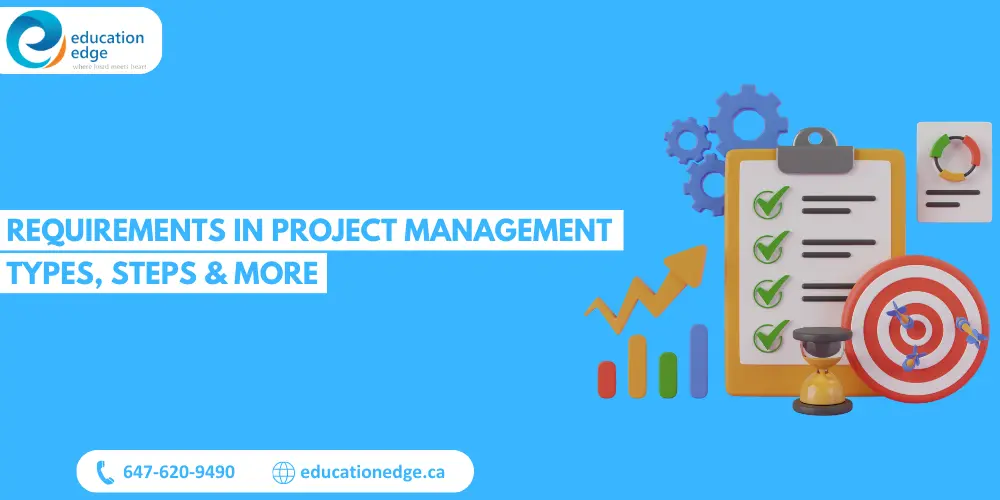
Every project has requirements, so every project manager’s job is to develop an effective strategy for managing them. The clarity and understanding of requirements in project management are essential for the project’s success.
Therefore, these requirements in project management work as guidance, directing the project toward its desired outcome while minimizing errors and risks. Additionally, they serve as a foundation for decision-making, assisting with resource allocation, risk assessment, and scope definition.
What are the Requirements in Project Management?
Project management requirements are detailed specifications and criteria that define a project’s scope, objectives, and deliverables. They include key features, functions, resources, and constraints that serve as the basis for project planning, execution, and evaluation.
Types of Requirements in Project Management
Here are some common types of requirements in project management:

1. Business Requirements
2. Solution Requirements
3. Stakeholder Requirements
Business Requirements
Business requirements include a project’s fundamental and long-term needs that support the organization’s long-term goals. Project management offices (PMOs) typically oversee the alignment of projects, programs, and portfolios with the strategic objectives of the organization.
Solution Requirements
Solution requirements define the essential functions, features, and attributes that a product or service must have in order to meet stakeholder and business needs.
Hence, they are classified as functional or non-functional requirements.
Functional requirements:
- These define the specific functions or features that a system or product should have.
- It is about specifying what the system must do to meet the needs of the business and stakeholders.
Non-Functional requirements:
- These are the criteria for determining how well a system performs certain functions.
- It’s about the system’s qualities, not just what it does.
Stakeholder Requirements
Stakeholder requirements in projects define the specific needs and expectations of every stakeholder involved, such as customers, end-users, sponsors, teams, officials, and others. These are critical in determining the scope, objectives, and development direction of a project.
Steps in the Project Requirements Process
Here are some important steps that will help you identify project requirements.
1. Identify Stakeholders and Discuss the Project:
- Identify key stakeholders such as organizational leaders, clients, and end-users.
- Conduct a meeting to discuss project details and gather diverse stakeholder perspectives.
- To fully understand what the project requires, write a brief overview of the discussions.
2. Define the Audience:
- Clearly define the end-users of the product.
- Understand user demographics, preferences, and knowledge.
- Tailor the product to meet the specific needs of the target audience.
3. Collaborate with the Development Team and Critical Players:
- Work closely with the product development team, product managers, and QA analysts.
- Collaborate with critical project players to finalize requirements effectively.
4. Determine the Scope of the Project:
- Identify and list all elements to be included in the project.
- Define the project timeline and stages in detail.
5. Categorize Requirements:
- Arrange project needs into two groups: functional and non-functional requirements.
- You can also add business and technical categories to improve organization and efficiency.
6. Connect Each Requirement to the Software’s Purpose:
- Verify that each requirement directly contributes to the project’s main purpose.
- Ensure that all requirements align to satisfy end-users and clients.
7. Use Clear, Precise Language:
- Document project requirements using precise and clear language.
- Avoid uncertainty to avoid misunderstandings caused by a lack of clarity.
8. Track Requirements:
- Use project management tools to effectively track and manage project requirements.
- Gain a complete view of the process and help team members identify their roles.
9. Document All Changes:
- Document changes in project requirements as the project progresses.
- Recognize that requirements may change and that new ones may emerge during the project.
Steps in Documenting Project Requirements
The process of documenting requirements entails careful detailing.
1. Making a Requirements List
A detailed document ensures that all aspects of the project’s requirements are documented.
2. Engaging Stakeholders in Review
Regular reviews with stakeholders help validate the documented requirements and ensure they meet their expectations.
Tips for Writing Project Requirements
Here are a few tips to help you write project requirements as effectively as possible.
- Involve end-users actively
- Keep it clear and brief
- Stay adaptable
- Use advanced tools effectively
- Guarantee thoroughness
- Establish a procedural framework
Summing up, clear and well-defined requirements are the foundation of effective project management. Projects can overcome challenges and increase their chances of success by understanding the different types of requirements, implementing an organized strategy, as well as executing best practices.
To ensure you meet all the essential project management requirements, earning a PMP Certification can prepare you with the skills needed to excel in this field.
Frequently Asked Questions
1. What are the types or requirements in project management?
ANS: There are 3 common types of requirements in project management
1. Business Requirements
2. Solution Requirements
3. Stakeholder Requirements
2. How important are project requirements to the overall success of the project?
ANS: Clear and well-defined requirements are essential to project success because they serve as a road map for the entire project team.
3. Why is stakeholder involvement essential in requirements gathering?
ANS: Stakeholders provide diverse perspectives, ensuring that the project aligns with higher objectives and expectations.
4. Why do we create requirements?
ANS: Writing clean and clear requirements can protect the team and business stakeholders from misunderstanding.







